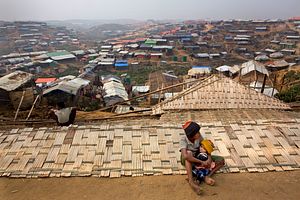If Rutger Bregman, author of the best-selling book “Humankind: A Hopeful History,” needs another example to support his argument that “Most people, deep down, are pretty decent,” Bangladesh is a perfect candidate.
This year, on the 50th anniversary of the country’s, pundits are applauding Bangladesh for its spectacular performance on social, economic, agriculture, and food security fronts. But the world failed to take notice that it has also taken a giant leap of humanity by caring for 1.3 million Rohingya refugees since 2017.
In August 2017, almost 700,000 refugees poured over the border, fleeing from the Myanmar army’s genocidal operations. Bangladeshis shuddered in horror and disbelief. Then they sprang into action organizing food, shelter, medicine, and healthcare. Has the world ever pondered how Bangladesh managed a surge of almost a million refugees in a single month? By way of comparison, the number is nearly equal to that of the 2015 refugee crisis in Europe, which almost broke the European Union apart.
The first credit should go to the Bangladeshi government. It opened up the border and mobilized the local administration, police, and army to maintain order. On September 10, 2017, the government started biometric registration of the refugees. Two days later, Bangladesh Prime Minister Sheikh Hasina herself visited the overflowing refugee camps. Her public show of empathy was an iconic personification of Bangladesh’s compassion.
Then came the NGOs, lead by BRAC, Bangladesh’s flagship non-government organization. It was active among the Rohingyas arriving in 1992, 2012, and 2016. Yet, it was not ready for the sudden influx of such a surge of additional refugees. In early September, BRAC started its Humanitarian Crisis Management Programme (HCMP) with internal resources. By then, the total number of refugees stood at almost 1.3 million, including those who had arrived earlier. The HCMP initially focused on day-to-day needs and then promoted the refugees’ long-term well-being. It emphasized sanitation, hygiene, education, health and nutrition, shelter, food security, disaster risk management, and overall camp management. The single fact that there was no diarrhea outbreak in the camps should be enough to show the sheer scale of the program’s achievements.
Let’s also not forget the local communities of Teknaf and the surrounding areas. Their wages went down; social services became over-stressed; petty crime increased; and drug and human trafficking became a significant problem. They all endured economic hardship. Yet, they responded with grace and generosity, noted the U.S.-based Center for Global Development.
Meanwhile, Bangladesh has to spend $1.2 billion each year to support the Rohingyas. Environmental degradation is continuing in Cox’s Bazar and its surroundings. An area of 4,300 acres has lost hills and forests. The refugees are burning almost 6,800 tons of fuelwood each month. The hilly terrain has lost its natural shape due to indiscriminate levelling, a practice known as hill cutting. Thousands of shallow tube wells are drying up the underground aquifers. Increased vehicular traffic and firewood burning are causing air pollution. Plastic bottles and polythene are choking up the drains.
The Bhashan Char (a newly formed island in the Bay of Bengal) story is illuminating. Bangladesh’s government has been pondering relocating some Rohingyas there since 2015. All international agencies opposed it, arguing that the island is prone to cyclones and storm surges. Bangladesh’s response is that millions of Bangladeshis live under constant threat of such natural disasters – and the Bhashan Char facilities are way better than those in Teknaf.
While the international community is quick to criticize Bangladesh, offers to help are far less frequent. The only country that has stood by Bangladesh, and taken a giant moral step toward ensuring justice, is the Gambia. It has filed a case against Myanmar at the International Court of Justice in the Hague for genocidal acts against the Rohingyas.
As a rule, the world moves from one crisis to another, and the older ones fade into the background. The international community at large lost interest in the Rohingyas long ago. The recent military coup in Myanmar could have refocused global attention on the bigger picture of the Myanmar problem. It is an opportunity for the world to address the current situation’s root causes, such as the long-running ethnic conflicts, the Rohingya issue, the ruling elites’ corruption, and misgovernance. Instead, there is a narrow focus on restoring Myanmar’s democracy – although it was always a profoundly disappointing one.
During his recent visit to Dhaka, U.S. climate envoy John Kerry stated: “Rohingyas are not only Bangladesh’s responsibility.” That is true, but Bangladesh needs actions, not statements, to support its efforts. It acted with grace and humility when the world failed. The world owes this big-hearted nation a standing ovation.

































